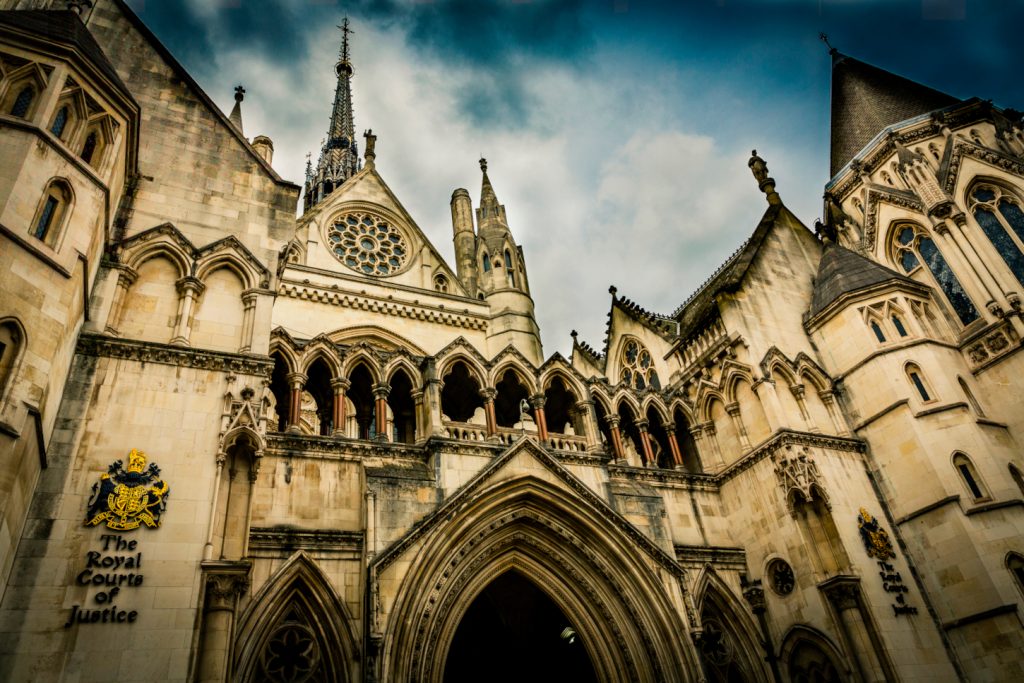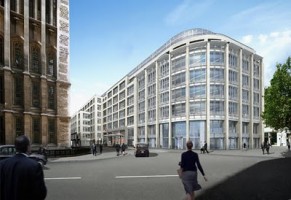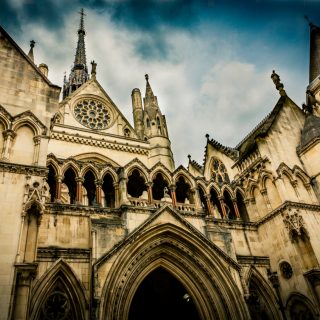Member of the Lawbore journalist team, Grace Costa, talks trends in architecture around legal buildings, asking whether the sway towards sleek modernism is a mistake…

Opened in 1882, the Royal Courts of Justice remains one of the oldest and most famous legal buildings in the United Kingdom. Architecturally designed as a cathedral, the Court’s High Victorian Gothic revival architecture completed in sandstone with granite, marble and red sandstone below slate roofing, commands awe in all who visit.
The building is so architecturally impressive and steeped in history that the exclusive tours offered by the Court are very popular; with students, tourists and others interested in the law, the history of London or architecture.
In stark contrast to this historic building in the centre of London is one of the newer law courts in Britain: the Rolls Building.

The Rolls Building opened in 2011 and specialises in financial, business and property litigation and high value dispute resolution. It houses the courts of the Chancery Division of the High Court, as well as the Commercial and Admiralty Court and the Technology & Construction Court (Kings Bench Division of the High Court). Instead of taking on a Gothic Revival aesthetic, the building takes an entirely different design; it is a hyper-modern, multipurpose skyscraper located in central London’s buzzing Holborn neighbourhood. Comprised largely of glass, the building lacks the personality and ornate detail synonymous with the UK’s older courts, which were mostly built in the 19th century. This includes the likes of the Royal Courts of Justice, as well as Victoria Law Courts in Birmingham (read an interesting piece about the VLC in RIBA journal). We also see this style of architecture most famously at the Palace of Westminster, the House of Lords of course previously operating as final Court of Appeal on points of law in the UK on civil matters and for England, Wales and Northern Ireland on criminal matters. This ended in 2009 when the UK Supreme Court took over jurisdiction.
Admirers of the modern ‘office-block’ style will of course point to the importance of glass within modern legal buildings; personifying the light and transparency we hope will be imbued on our justice process. Paul Magrath at the ICLR, compares the Rolls Building’s “light and airy atrium” to the “somewhat gloomy atmosphere of the main Royal Courts of Justice building”. Those who have visited the UK Supreme Court (formerly Middlesex Guildhall) in Parliament Square will note this building manages to combine both modern and traditional styles.
Budget-friendly versus imposing architecture — is there a social aspect?
Gothic architecture is beautiful and breathtaking, but such careful detail and use of luxury materials comes at a great cost. On the surface, this appears as the most obvious reason for the trend towards the simplification and clean lines inherent in modern architecture used in the construction of the UK’s newest law buildings. In the 19th century, the Crown and government splurged in earnest on the erection of large buildings in the country’s capital to exemplify the prowess and power of the empire. At a time when their beloved empire was growing and receding in a constant pulse, these buildings strategically boasted of the UK’s domestic power as a signal to their powers abroad of the Crown’s stability. However, as this empire shrank and the world turned to modernisation conducive with simplification, excessively expensive buildings were no longer feasible. Social spending increased and calls for social justice re-routed funds from the erection of unscrupulously expensive public buildings used by few members of society to more equitable pursuits. Public housing and healthcare became the name of the day, eclipsing opulent architecture.
What effect does this have on society?
However, the simplification of design of public buildings, in law and across all public domains, comes at another, unlikely great cost. During World War II, in 1943, Winston Churchill famously said, “…we shape our buildings and afterwards our buildings shape us” after seeing the damage wrought by bombs on the House of Commons and contemplating their repair.
Corroborating this, various studies have shown that architecture can have far-reaching effects – affecting moods and perceptions. In a piece on BBC Future, we hear of how hyper–modern but stiflingly plain apartment buildings built in St Louis, Missouri, had to be demolished in 1972 as their redundant architecture “discouraged community” and was linked to high crime rates in the area. As the link between architecture and psychology became apparent in the late 20th and 21st century, architects began to implement the type of structures that society found appealing into their designs. According to BBC Future, studies show that complex facades elicit positive mental effects.
Green spaces have been shown to evoke a similar response.
However, in cities such as London or New York, these complex designs, more akin to Gothic architecture than modernism, are seldom built now. The Rolls Building offers a prime example of a new structure lacking any intricacies – it is in essence, a glass box. These glass and steel structures, while cheaper and designed for utility and accessibility, may have negative effects on users. While architects defaulted to minimalism for its cost-effectiveness and utility benefits, it may have a detrimental effect on society. Ostensibly, it may just seem that minimalism’s dangers are just how boring, plain and actually aesthetically unpleasing they render our cityscapes. Instead of adding personality to architecture, the default to minimalism has created a dull environment, bordering on unpleasant according to some architects.

Worse than the surface level aesthetic displeasure is the reality that plain, sterile buildings cause anxiety and uneasiness in those who use them, and it is important that the city’s future architects take these studies into consideration. It may be cheaper, but is cheaper necessarily better?
Sterile environments like that at the Rolls Building may in fact be more intimidating than the Gothic architecture of the Royal Courts of Justice. The government, and the architects they employ, would benefit greatly from prioritising study into how these two buildings make the people who frequent them, feel. They have the opportunity to implement designs that bridge the gap between minimal modernism and nuanced detail that may have a more positive effect on moods when utilising the buildings, especially law courts where anxiety is likely to be already high for most who use them. Re-introducing some of the complexity, and its inherent beauty, into London’s cityscape may be worth the higher cost, ensuring the preservation of London’s uniqueness architecture and beauty for eternity. The personality of Gothic architecture may appear daunting and intimidating, but isn’t cold glass and steel even more so? We must ask if London would rather make a conscious choice to remain a cultural hub marked by the presence of its timeless architecture, or become a hyper-modern city diluted in the historic charm that gives the city its magic.
Want to read more on this? Check these out:

Artichoke, The Danger of Minimalist Design (& the Death of Detail)
Easy Render, Gothic Style in Modern Architecture: Bringing the Middle Ages to the 21st Century
Layers of London, Record of the Royal Courts of Justice
Culture South West, The 10 Oldest Court Buildings in the UK
Owen Bowcott, The Guardian, New court complex planned to bolster City of London after Brexit (9 Oct 2017)
Michael Bond, BBC Future, The hidden ways that architecture affects how you feel (6 June 2017)
Grace Costa is in the second year of completing the LLB Programme at the City Law School. She has a Bachelor‘s of Science degree in History and Political Science from a Liberal Arts College in Elon, North Carolina in the United States! She loves reading, anything from the current events to fiction, and has a passion for politics.
She is most excited to combine her interests in reading and writing this semester through Lawbore and hopes to one day practice as a lawyer in her home country, Trinidad and Tobago after graduating from City!


I loved this article! In my opinion the gothic architecture is so beautiful and really adds character whereas plain glass buildings just look the same as any other building.